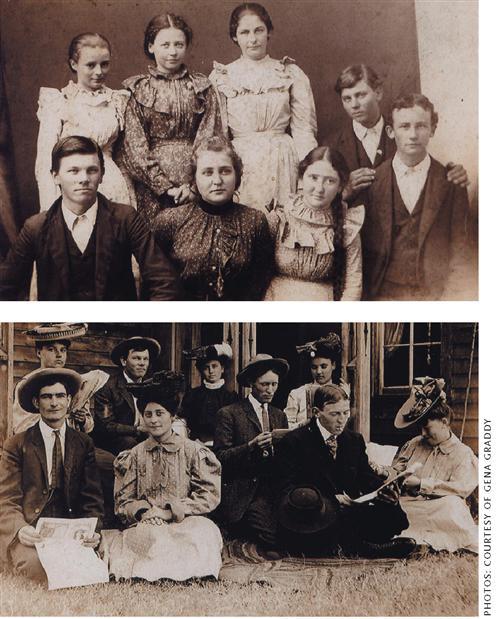Sign up for the Family Tree Newsletter Plus, you’ll receive our 10 Essential Genealogy Research Forms PDF as a special thank you!
Get Your Free Genealogy Forms
"*" indicates required fields
Gena Graddy thinks these two portraits depict the same branch of her family. The photographs came from her great-aunt Grover Taylor, the young woman with the braid in the front row of the top portrait. Unfortunately, Taylor didn’t caption her pictures, so it’s unclear if the subjects of these images match up. To find out, Graddy must rely on photographic clues and genealogical details. You can follow the same process to solve your own group-portrait predicaments.
Of course, the best photo identifications come from the people in your pictures — though you won’t always have access to them. Identifications passed down through oral tradition, but not recorded, tend to be fuzzy; people forget or mix up facts as they tell and retell the details. In this case, Taylor told relatives that both photos depict her siblings, but she didn’t attach names to their faces.
When trying to identify children in photographs, it helps to know your relatives’ life dates, since you usually can estimate the subjects’ ages. For instance, the oldest girl in the top photo appears to be in her early 20s, and the youngest looks about 10. Graddy knows that the eldest Taylor girl was Elizabeth. The oldest sibling in the top picture is the woman in the front row next to Grover. This could be Elizabeth — but there’s a problem with that conclusion. Elizabeth was born in 1862, and her youngest sibling was born in 1885. That 23-year age difference doesn’t add up in this picture. If the youngest girl (in the upper-left corner) is 10, then Elizabeth would have to be 33, which doesn’t seem likely. Perhaps the photographer captured a mix of siblings and cousins, not just brothers and sisters. It’s also possible that the oldest girl in this photo is another sister.
To establish a time frame for an image, you must look for details such as a photographer’s imprint and clothing clues. Neither of Graddy’s pictures gives the photographer’s name, so dating them depends on style analysis. According to Children’s Fashions 1860-1912: 1,065 Costume Designs from “La Mode Illustrée” edited by JoAnne Olian (Dover Publications), ruffled yokes, such as those on the girls’ handmade dresses in the top photo, first came into style in the early 1890s. The large wide-brimmed hats in the bottom image suggest a date around 1905.
So who’s who? Looking for physical similarities between the two groups helped Graddy find at least one match. The young man on the far left in the top picture has distinctive facial features that help him stand out in the back row of the bottom photo (he’s second from the left). Although Graddy can’t name the man yet, at least she’s identified him in both pictures.
Next, Graddy compared the faces in these images with those in identified photographs. This resulted in two possible identifications in each picture. To confirm her suspicions, Graddy will contact relatives for additional images of these people.
With the photographs taken about 10 years apart, it appears that the children in the top picture are the adults in the bottom photo. Graddy knows that several of the Taylor siblings died of tuberculosis starting in 1901, not long before the second photo was taken. Genealogical data will provide names and life dates to help with the identification process. As long as she repeats the matching game using other identified photos, Graddy should be able to name the rest of the individuals.
Solving a group-photo mystery takes time, but it’s worth the extra effort. Once you’ve identified all the subjects, you can use the picture as a Rosetta stone to unpuzzle other pictures.
From the April 2005 Family Tree Magazine
ADVERTISEMENT


